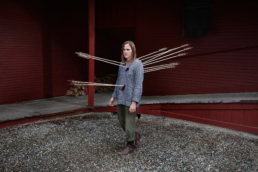May 7 – June 18, 2022
Opening: Saturday, May 7, 2022 from 3:00 to 5:00 p.m.
Land Back: Lori Blondeau, Raven Chacon, Tracey-Mae Chambers, Gregg Deal, Jeremy Dennis, Duane Isaac, Ursula Johnson, Cheryl L’Hirondelle, Logan MacDonald, Meagan Musseau, Camille Seaman, Julia Rose Sutherland
Curator: Michael Patten
Contemporary Native Art Biennial (BACA) – 6th edition
Free shuttle to Sherbrooke on April 28.
Departure from Montreal at 2:30 pm from gallery Art Mûr
RSVP BACA
Free shuttle to Pointe-Claire on May 8.
Departure from Montreal at 1:00 pm from gallery Art Mûr
RSVP BACA
galerie Art Mûr
5826, rue St-Hubert
Montréal, (Québec) Canada, H2S 2L7
Since time immemorial, indigenous peoples have preserved biodiversity in the face of continued human population growth. Shortly after the time of first contact with Europeans, indigenous communities were stripped of their ancestral lands; the Land Back movement aims to restore governance and stewardship of the territory for a sustainable future.
If Land Back is a call to action, a return of equity to a stolen territory, it also allows for some questioning. How can we best protect biodiversity, land and water? The first step would be to return the land to its traditional and legitimate protectors. The revalorization of indigenous knowledge goes beyond symbolic gestures of recognition or inclusion; it aims to significantly change practices and structures.
The motif of the rock traces an Ariadne’s thread between the practices of several artists presented. It is posed as a marker of meaning, but also of territory; a sort of meeting point and support for these peoples dispossessed of their ancestral territories. The rock is solid, but it can be fragmented.
In her photographic series Asiniy Iskwew (“Rock Woman” in Cree), Lori Blondeau addresses the destruction of Mistaseni – a 400-tonne sacred rock and gathering place for the South Saskatchewan River Dam Project. Carefully choosing her location, she captures her self-portrait; standing on a rock, wearing a red dress, looking defiant. Through these photographs, the artist pays tribute to the resilience of indigenous women in the face of systemic violence. In this echo, Meagan Musseau, through a poetic gesture, patiently braids long ribbons of tulle hung on a root system, while they are carried away by the wind. The artist thus anchors her gesture in the land and deepens her relationship with it.
Photographer Camille Seaman extensively documented the Standing Rock Reservation protest in 2016, in North Dakota. This rally had taken a stand against the Dakota Access pipeline, which was completed in 2017. One of these photographs bears the title Protect & Serve (The Corporations), it depicts a lone protester facing a heavily armed police convoy.
In parallel, other artists are joining this more politically engaged discourse with very striking imagery. Not mincing her words, Julia Rose Sutherland uses the technique of quill embroidery to write activist slogans in her series Rest in peace Rodney Levi. Gregg Deal, in his work The Last American Indian on Earth, develops a discourse on Indigenous identity and the racist stereotypes associated with it by documenting his encounter with average Americans as he depicts a stereotypical version of an Indigenous person.
For his part, Jeremy Dennis, in his series Nothing Happened Here, exposes in a crude way the violence left by colonialism, using the bloody arrow as a symbol. Duane Issac, also through photography, articulates a discourse on the connection between indigenous bodies and their land and how the well-being of one is intimately linked to the survival of the other.
Strongly representative of the Land Back movement, these productions stand as symbols of strength and resistance.
We recognize that BACA is taking place on unceded Indigenous lands, and that the Kanien’kehá:ka Nation is the caretaker of the lands and waters on which we gather today. Tiohtiá:ke (Montreal) is historically known as a gathering place for many First Nations. Today, it is home to a varied population of Indigenous and other peoples. BACA acknowledges the continued relations with the past, present, and future in their current relationships with Indigenous and other peoples within the Montreal community.
The Biennale d’art contemporain autochtone (BACA) thanks the Canada Council for the Arts, the Government of Québec (Conseil des arts et des lettres du Québec, Fonds d’investissement pour le rayonnement de la Métropole), Tourisme Montréal, the Conseil des arts de Montréal, Art Mûr and its other presenting partners.

